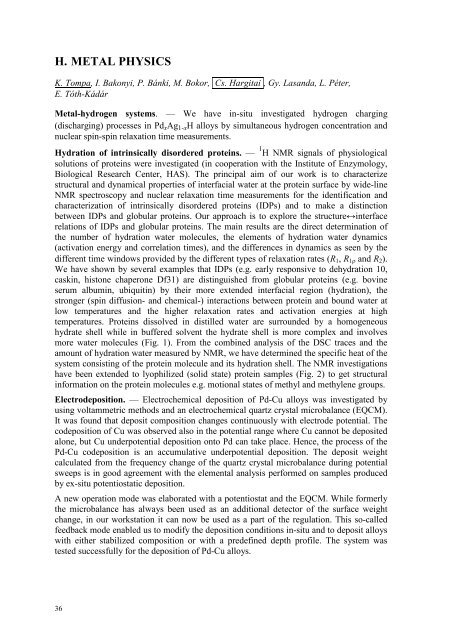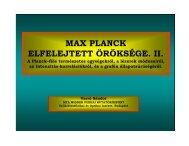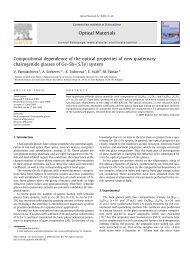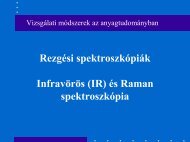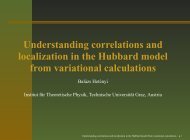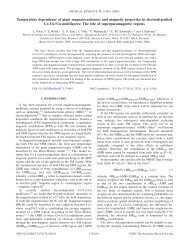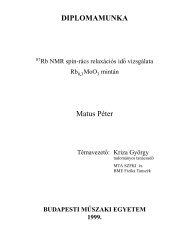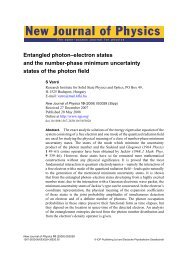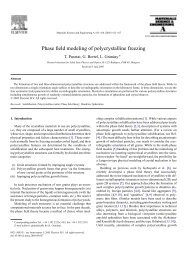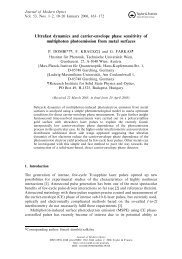ANNUAL REPORT - MTA SzFKI
ANNUAL REPORT - MTA SzFKI
ANNUAL REPORT - MTA SzFKI
Create successful ePaper yourself
Turn your PDF publications into a flip-book with our unique Google optimized e-Paper software.
H. METAL PHYSICS<br />
K. Tompa, I. Bakonyi, P. Bánki, M. Bokor, Cs. Hargitai , Gy. Lasanda, L. Péter,<br />
E. Tóth-Kádár<br />
Metal-hydrogen systems. — We have in-situ investigated hydrogen charging<br />
(discharging) processes in Pd x Ag 1-x H alloys by simultaneous hydrogen concentration and<br />
nuclear spin-spin relaxation time measurements.<br />
Hydration of intrinsically disordered proteins. — 1 H NMR signals of physiological<br />
solutions of proteins were investigated (in cooperation with the Institute of Enzymology,<br />
Biological Research Center, HAS). The principal aim of our work is to characterize<br />
structural and dynamical properties of interfacial water at the protein surface by wide-line<br />
NMR spectroscopy and nuclear relaxation time measurements for the identification and<br />
characterization of intrinsically disordered proteins (IDPs) and to make a distinction<br />
between IDPs and globular proteins. Our approach is to explore the structure↔interface<br />
relations of IDPs and globular proteins. The main results are the direct determination of<br />
the number of hydration water molecules, the elements of hydration water dynamics<br />
(activation energy and correlation times), and the differences in dynamics as seen by the<br />
different time windows provided by the different types of relaxation rates (R 1 , R 1ρ and R 2 ).<br />
We have shown by several examples that IDPs (e.g. early responsive to dehydration 10,<br />
caskin, histone chaperone Df31) are distinguished from globular proteins (e.g. bovine<br />
serum albumin, ubiquitin) by their more extended interfacial region (hydration), the<br />
stronger (spin diffusion- and chemical-) interactions between protein and bound water at<br />
low temperatures and the higher relaxation rates and activation energies at high<br />
temperatures. Proteins dissolved in distilled water are surrounded by a homogeneous<br />
hydrate shell while in buffered solvent the hydrate shell is more complex and involves<br />
more water molecules (Fig. 1). From the combined analysis of the DSC traces and the<br />
amount of hydration water measured by NMR, we have determined the specific heat of the<br />
system consisting of the protein molecule and its hydration shell. The NMR investigations<br />
have been extended to lyophilized (solid state) protein samples (Fig. 2) to get structural<br />
information on the protein molecules e.g. motional states of methyl and methylene groups.<br />
Electrodeposition. — Electrochemical deposition of Pd-Cu alloys was investigated by<br />
using voltammetric methods and an electrochemical quartz crystal microbalance (EQCM).<br />
It was found that deposit composition changes continuously with electrode potential. The<br />
codeposition of Cu was observed also in the potential range where Cu cannot be deposited<br />
alone, but Cu underpotential deposition onto Pd can take place. Hence, the process of the<br />
Pd-Cu codeposition is an accumulative underpotential deposition. The deposit weight<br />
calculated from the frequency change of the quartz crystal microbalance during potential<br />
sweeps is in good agreement with the elemental analysis performed on samples produced<br />
by ex-situ potentiostatic deposition.<br />
A new operation mode was elaborated with a potentiostat and the EQCM. While formerly<br />
the microbalance has always been used as an additional detector of the surface weight<br />
change, in our workstation it can now be used as a part of the regulation. This so-called<br />
feedback mode enabled us to modify the deposition conditions in-situ and to deposit alloys<br />
with either stabilized composition or with a predefined depth profile. The system was<br />
tested successfully for the deposition of Pd-Cu alloys.<br />
36


